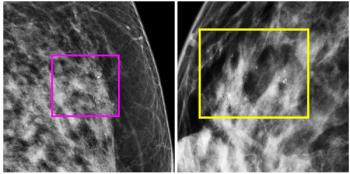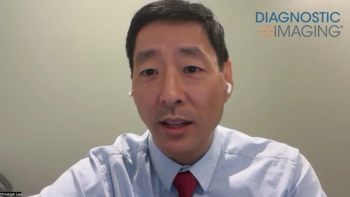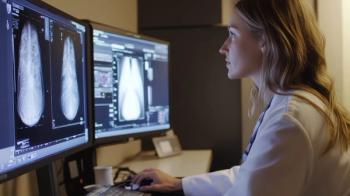
Teleradiologists tap neglected long-distance breast imaging
A 1996 National Aeronautics and Space Administration report speculated that telemammography could be used to connect neglected rural patients with timely, critical medical expertise-if only an adequate communications infrastructure in these areas could support such an undertaking. NASA went on to predict that global satellite networks then evolving could bring low-cost telecommunications infrastructure connectivity to virtually any location.
A 1996 National Aeronautics and Space Administration report speculated that telemammography could be used to connect neglected rural patients with timely, critical medical expertise-if only an adequate communications infrastructure in these areas could support such an undertaking. NASA went on to predict that global satellite networks then evolving could bring low-cost telecommunications infrastructure connectivity to virtually any location.
A decade later, the Internet is solidly established, yet telemammography has yet to gain much traction as a viable business enterprise. Several factors have conspired to inhibit more substantial growth in telemammography: insufficient numbers of mammographers to meet growing screening mammography demands, the need for specialized equipment to transmit and display mammograms, and the litigious nature of the field of mammography itself.
As a result, the subspecialty of digital telemammography has generally been neglected by the teleradiology sector, even though mammography is one of radiology's most common and most important specialties-one that likely saves more lives than anything else radiologists do. Research indicates that annual mammograms for women 40 years or older decrease breast cancer mortality by 30% to 40%.
In a recent industry about-face, a number of teleradiology groups have discovered business opportunities lurking in this vacuum, and they have begun forming telemammography divisions. Online Radiology Medical Group, for instance, announced at the RSNA meeting they are now ready to accept digital screening mammography. The Riverside, CA, teleradiology group of 25 multispecialty radiologists is currently seeking beta customers to shape its telemammography section.
"We believe there is a great demand for more radiologists who can read mammograms, based on requests and comments we've heard over the last couple of years from our customers and other imaging center administrators at various radiology conferences," said Jesse Salen, Online Radiology's vice president of sales and technology.
Salen said Online Radiology intends to help fill that niche. Other firms hoping to meet the need include RSI, an Atlanta teleradiology firm of 10 radiologists that also recently opened its lines to telemammography under a separate, related company called Digital Mammography Specialists.
"Digital Mammography Specialists was created in March 2007 to answer the call for rapid turnaround on mammography," said RSI president Dr. Raja P. Reddy.
Hospitals and imaging centers are currently outsourcing mammography not just because of the shortage of mammographers, but as a means of improving report turnaround times, which typically range from three to seven days for a screening mammogram, he said.
"We are able to produce a final report in 24 hours or less," Reddy said. "For clients used to waiting six or seven days, that's a huge improvement."
The business opportunity presented by telemammography was one of the lures for Reddy. He believes that the advent of digital technology makes telemammography a viable financial option, as both a business and an outsourcing solution for hospitals and imaging centers.
"While mammography is a field that has been unjustifiably neglected, it would be incorrect to say it's not financially feasible to be able to provide this service," he said.
Given the amount of resources needed for a high-quality mammography program, financial success depends significantly on an efficient workflow model, according to Reddy.
SPINOFF SUBDIVISION
USTeleradiology also recently spun off a subdivision of teleradiologists now dedicated to telemammography. Veteran mammographer Dr. Martha Garrison is CEO of USTeleMammography.
"I knew five years ago, when digital really started coming out, the demand for mammographers would go up and breast imaging centers were going to close because there wouldn't be enough radiologists to read the studies," Garrison said.
USTeleMammography was formed in February 2006 not only to elevate the standard of care in women's imaging, but also to relieve radiologists of the mammography studies they often prefer not to read.
"When teleradiology first appeared, some imaging centers were resistant to that business model because they feared it would encroach on their territory," Garrison said.
But with the service she's offering, hospitals and imaging centers can outsource studies they don't want to read, because they consider them either too boring or too risky, and send their screening mammograms to her. Garrison was also attracted to the notion of providing better women's imaging to rural patients with little access to mammographers.
"Small rural hospitals don't have the throughput to justify full-time radiology support onsite, but with telemammography, I'm now able to offer my expertise to everyone, not just urban patients." she said.
Garrison's expertise is extensive. She estimates that she has read over 120,000 mammograms in her 10-year breast imaging career.
"Our telemammography business is picking up," Garrison said.
USTeleMammography has several accounts and several others awaiting final decisions, and the company is growing steadily enough that Garrison is considering hiring a third mammographer. It offers 24- to 48-hour turnaround for final reports, depending on when prior studies arrive for comparisons. Easy, rapid access to priors is one of the most persistent problems faced by all telemammographers.
"The availability of digital comparison studies is lacking," said Dr. Philip A. Templeton, president and CEO of Templeton Readings, a Sparks, MD, a teleradiology company formed in 2001.
Templeton Readings is another group currently reconfiguring to support telemammography. Unavailability of prior images necessarily slows the telemammography process, since final reports cannot be produced until comparison studies are considered.
"Most clients have to send film or consider digitizing priors for the radiologist to compare with the current exam," Templeton said.
LICENSE TO HEAL
Credentialing is another major obstacle. Mammographers, like all radiologists, must be licensed in the state where the study originates, not merely in the state where it is read. Licensure for teleradiology is another matter. Currently, state regulations vary widely, but to be on the safe side, many teleradiology companies opt to be licensed in every state. This can be a financial burden, especially on smaller telemammography operations.
"It can be a key holdup," Garrison said.
She currently has licenses in about 25 states at a cost of $2000 or more per state.
"We have a credentialing department that helps us stay current, but it still takes a lot of time and money," she said.
Several other special considerations affect any teleradiology group positioning itself to accept telemammography reads. Technical and financial challenges include investment in a mammography-capable PACS; an approved mammography reporting system; and DICOM-compliant, FDA-approved 5-megapixel monochrome monitors. Most conventional PACS use 3-MP monitors, which are not FDA-acceptable for viewing digital mammography exams. Top-of-the-line high-resolution 5-MP displays can cost $20,000 to $30,000.
"The challenges are significant, whether it's utilizing FDA-approved workstations that have to be continuously monitored for quality or providing unique workflow solutions for clients that have different and sometimes incompatible equipment," Reddy said.
Compatibility with client sites is a constant concern. Garrison's small telemammography operation employs a full-time information technology expert to anticipate, intercept, and resolve compatibility issues.
"Our main problem with all this is image distribution," she said.
USTeleMammography generally relies on virtual private networks between client sites and its offices, which means inevitable integration issues, beginning with the client's firewall.
"It's a major headache," Garrison said.
Then there is the problem of having adequate bandwidth available to transmit large mammography files from the acquisition site to the reading rooms. Due to the extraordinarily high resolution of mammography images, full-field digital mammogram files can exceed 100 MB per study.
Beyond the technical challenges are significant regulatory obstacles. Each mammographer must earn 15 mammography CME hours and eight digital mammography CME hours every three years. Every mammographer must read 940 mammography studies every two years, according to American College of Radiology guidelines, which were instituted by the Mammography Quality Standards Act.
None of these issues is a showstopper, even though only a small percentage of teleradiologists meet these criteria, since most teleradiologists spend little time reading mammography exams.
"We see the regulatory issues as challenges that have solutions rather than as roadblocks," Salen said.
LIABILITY ISSUES
Breast imaging is generally associated with a higher liability for radiologists than nonbreast imaging, so malpractice insurance is a major concern for telemammography groups.
"Any telemammography company must verify with its malpractice insurance agent that its mammographers are covered under their policy," Salen said.
This may require higher premiums for a group just launching a telemammography service.
It may fairly be asked whether the effort necessary to surmount these mammography-specific technical, financial, administrative, and insurance hurdles is worth the risk, particularly in light of relatively low Medicare reimbursement rates. Medicare reimburses $131.50 for digital screening mammography and $142.50 for digital diagnostic mammography. By comparison, the Medicare reimbursement rate for MR imaging of extremity joints is $509.34.
"We understand this position, but considering the fact that mammography is not affected by the 2005 Deficit Reduction Act, that demand for telemammography is high given the shortage of radiologists who read mammograms, and that an imaging center that needs help with mammography may likely need help with other modalities, we believe that there is a need for an ambitious teleradiology company or two to help out by offering telemammography services," Salen said.
Reddy considers the risk in telemammography no greater than anything else in mammography.
"Society has done such a tremendous job of raising awareness of the prevalence of breast cancer in the community that I sometimes feel that when women learn they have breast cancer it's almost an empowerment-they know they can do something about it and feel an immediate desire to beat it," he said.
Reddy said the last thing that comes to women's minds is to question whether the cancer was missed earlier. More people feel that mammography is one of the few areas where the compassion of medicine is really present.
"Between the radiologists and the technicians, most women have a good experience whenever they go for a mammogram," he said. "I think it's hard to look upon a positive imaging experience as somehow being perceived as someone not doing their job."
In spite of the financial and technical challenges and liability risks, mammography experts believe the future of mammography lies in telemammography. In 2005, 37.7 million mammography procedures were performed, up 2% from 2004. With the number of radiologists who want to read mammograms down and fewer residents going through mammography fellowships, the number of radiologists qualified to read mammography studies continues to decline.
"There just aren't enough mammographers to go around," Garrison said. "Instead of me going to five or six hospitals, those hospitals now come to me."
Mr. Page is a freelance writer based in Pine Mountain, CA.
Newsletter
Stay at the forefront of radiology with the Diagnostic Imaging newsletter, delivering the latest news, clinical insights, and imaging advancements for today’s radiologists.

























